How to Use Active Listening Skills in Sales to Win More Deals
Casey O'Connor
Active listening is a communication skill that fosters thorough, mutual understanding between all parties in a conversation.
Active listening skills can be a great asset for any salesperson. When salespeople are able to master active listening skills, they understand their prospects better, improve their sales pipeline, and close more deals.
In this article, we’ll go over everything you need to know about active listening, including what it is, why it’s so important, and some of the most critical active listening skills for salespeople to master.
Here’s what we’ll cover:
- What Is Active Listening?
- Why Is Active Listening Important in Sales?
- 11 Active Listening Skills for Sales
- Active Listening Examples
What Is Active Listening?
Active listening describes the act of listening in a way that fosters mutual understanding.
Active listening means doing more than just hearing the words coming out of someone’s mouth; it means listening, understanding, and retaining the real meaning behind what the speaker is saying (and, in some cases, not saying). 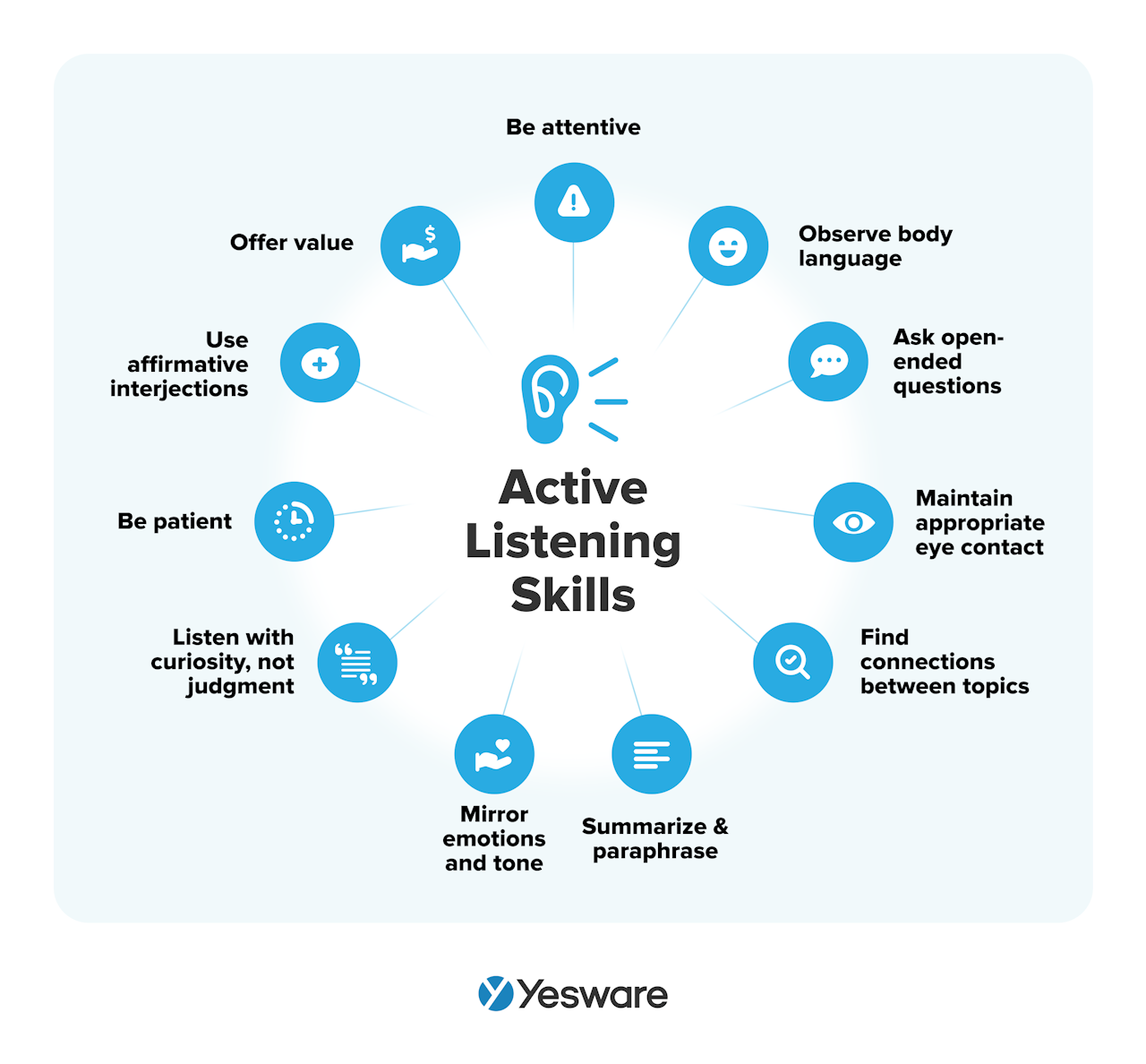 Active listening is an extremely important interpersonal skill that can be beneficial to any personal or professional relationship. It helps strengthen trust and understanding and can be especially powerful in fields like teaching, coaching, and sales.
Active listening is an extremely important interpersonal skill that can be beneficial to any personal or professional relationship. It helps strengthen trust and understanding and can be especially powerful in fields like teaching, coaching, and sales.
Salespeople in every industry and role can benefit from improving their active listening skills.
Why Is Active Listening Important in Sales?
Active listening may seem like a skill that only certain people can or need to pull off, but the truth is that every salesperson can and should learn to listen more actively.
Active listening is an important component of emotional intelligence and empowers salespeople to lead conversations in a way that ensures all communicating parties are heard and understood to their satisfaction.
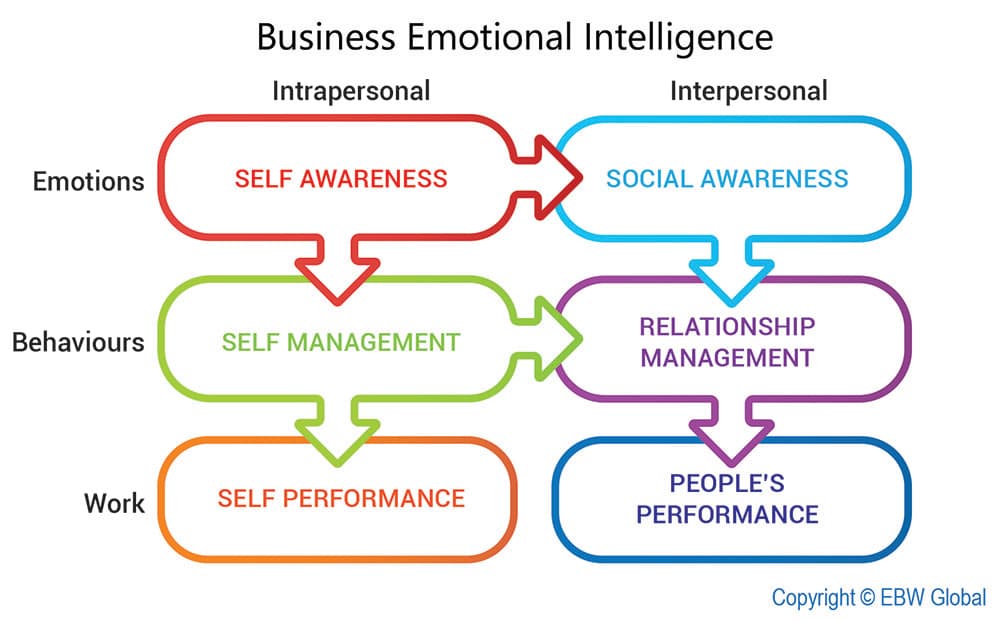
Active listening improves sales reps’ relationships with prospects and customers, improves individual sales rep performance, and improves the efficiency and effectiveness of the sales process overall.
Improves Sales Rep/Prospect Relationship
Active listening enables sales reps to show prospects just how important their concerns truly are to them. When prospects feel like the sales rep cares about meeting their unique needs, they’re more likely to share authentically about their pain points and non-negotiables. 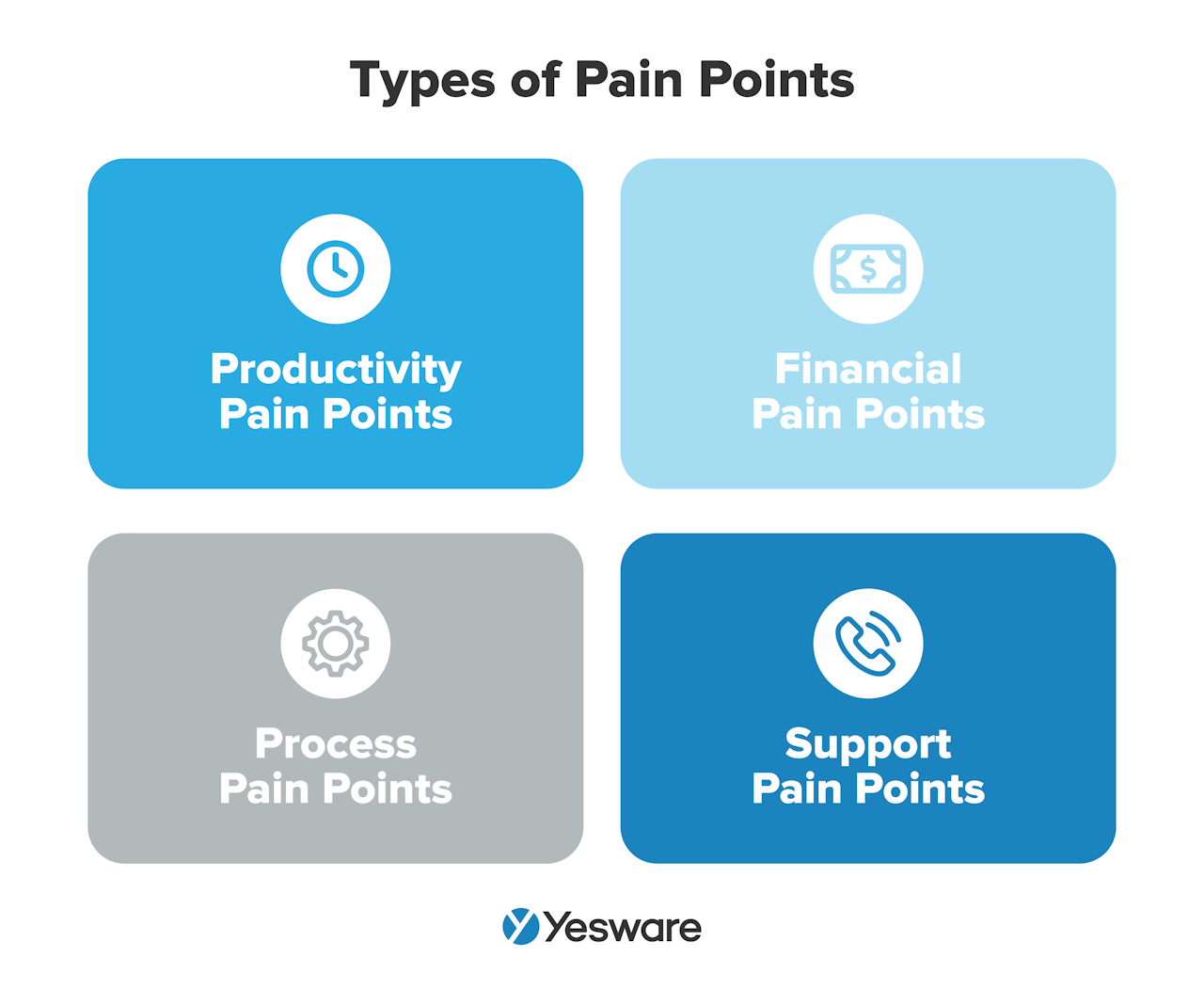 This kind of open dialogue often leads to fewer and/or less forceful sales objections.
This kind of open dialogue often leads to fewer and/or less forceful sales objections.
Improves Sales Reps’ Performance
When sales reps use active listening skills, they improve the likelihood that they’ll understand the prospect’s concerns and needs in a complete enough way that allows them to offer a personalized, valuable, and highly compelling solution.
By that same token, active listening also helps sales reps ensure that they don’t miss any critical information that the prospect shares; it can also help highlight any gaps in information if the prospect inadvertently neglects to share something.
Active listening helps sales reps gain a more thorough and meaningful understanding of what each prospect needs, which in turn allows them to create more personalized solutions that lead to a better close rate.
Improves the Overall Sales Process
Active listening helps sales reps and prospects get on the same page early in the sales process about the specific problem at hand, as well as the desired solution.
Sales reps who don’t use active listening skills may find that they discover too deep into the sales process that they’ve been investing time and resources into a prospect that wasn’t a good fit from the start. They may also struggle to come to a consensus about the appropriate solution for their specific needs.
11 Active Listening Skills for Sales
Active listening is what’s known as a “soft skill.” A soft skill is an interpersonal trait that can be practiced and improved upon. Sales reps hoping to improve their active listening skills should be willing to shadow sales reps who are proficient in this skill and be eager to hear their feedback.
Here are 11 of the most effective active listening skills for sales reps to master as they practice conversing for deeper understanding.
1. Be Attentive
The first and easiest step in active listening is noticing the obvious. Take note of the prospect’s apparent mood, tone, and choice of words. These are your first clues when it comes to understanding how the speaker feels and what exactly they need.
2. Observe Body Language
A large part of active listening is noticing how the speaker uses their body to communicate (consciously or not). This can include factors like facial expressions, filler words or non-verbal utterances (“um,” “uh,” clearing of throat, etc.), body language, posture, and more.
Great active listeners are often able to “read into” the non-verbal ways the speaker uses to communicate their feelings and mindset about the conversation.
Here are some body language tips taken from our Psychology Principles ebook. 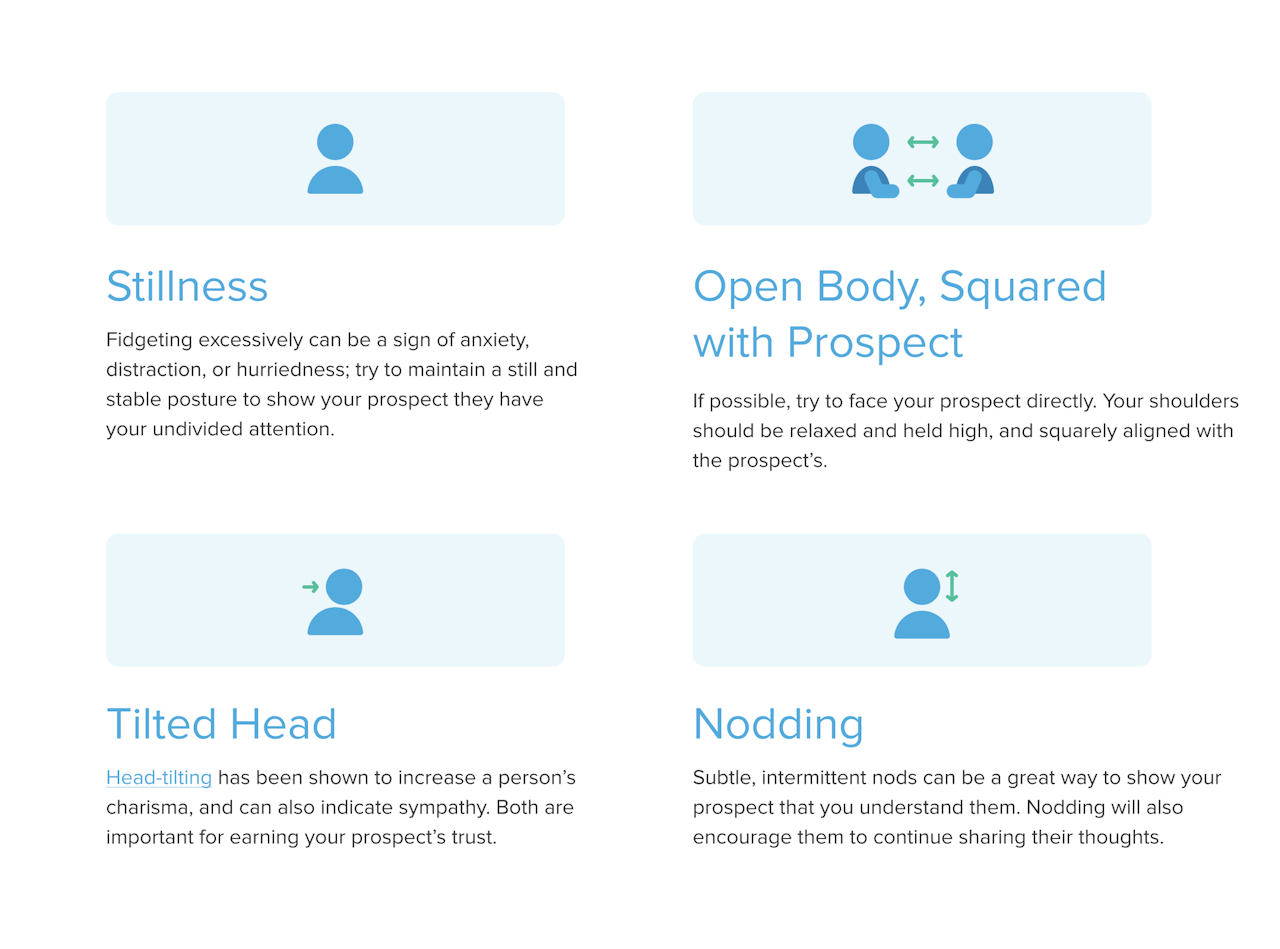 Download the full ebook here:
Download the full ebook here:
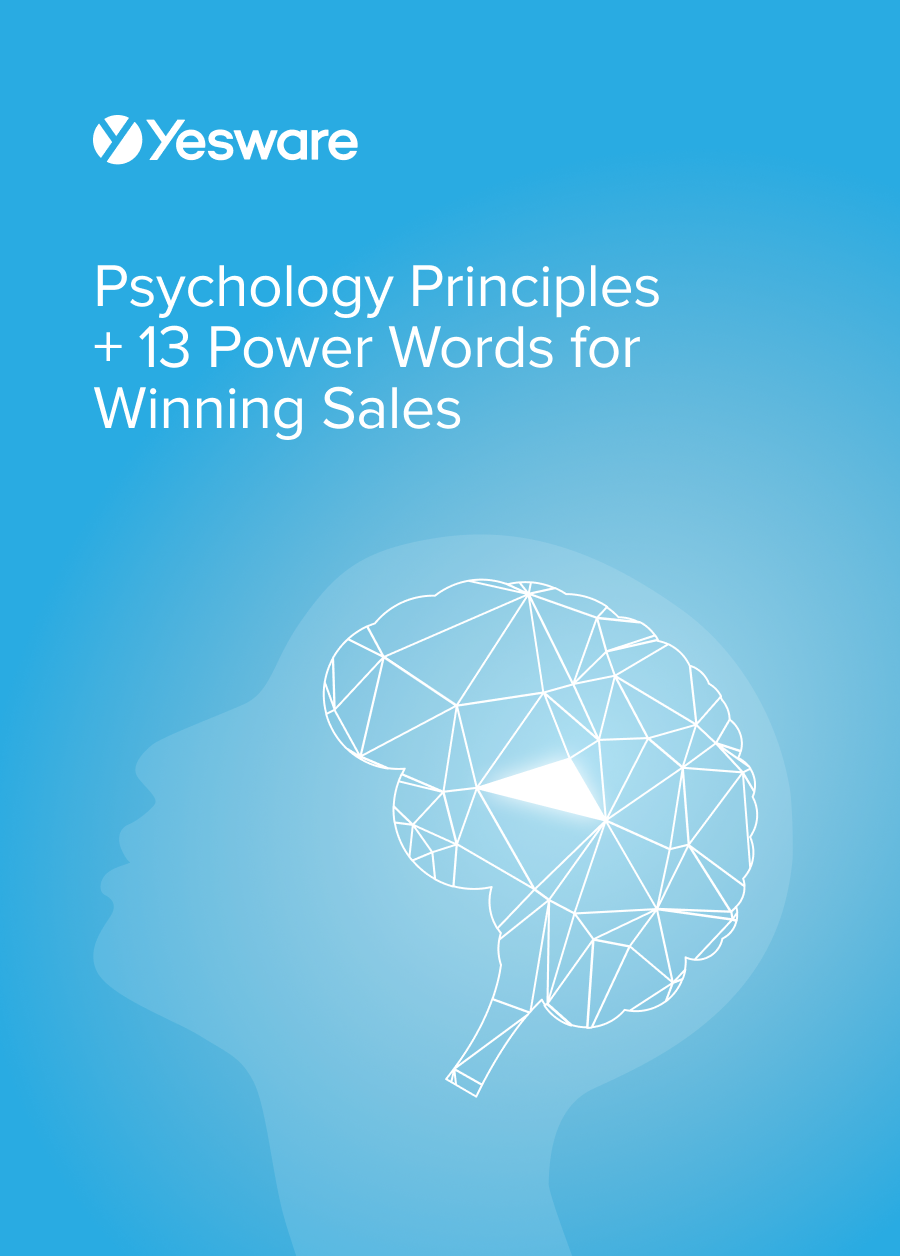 Psychology Principles + 13 Power Words for Winning SalesData-backed psychological principles, nonverbal cues, and persuasive phrases to win more deals.
Psychology Principles + 13 Power Words for Winning SalesData-backed psychological principles, nonverbal cues, and persuasive phrases to win more deals.
3. Ask Open-Ended Questions
Active listening means knowing when a prospect has more to share, and how to dig further for more valuable insights.
Open-ended questions can be very helpful in these cases. 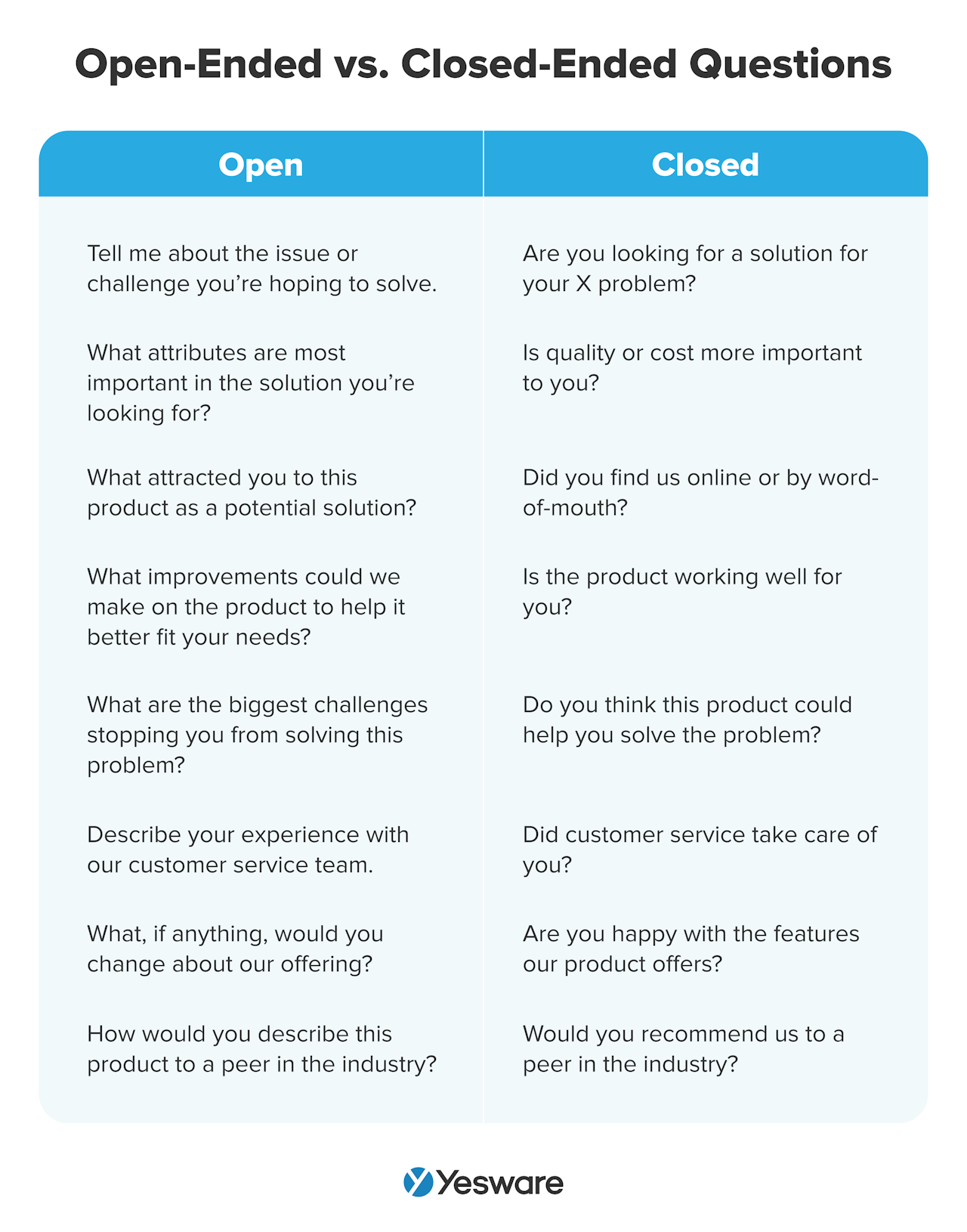 Open-ended questions help sales reps get to the heart of what prospects are really looking for and trying to communicate.
Open-ended questions help sales reps get to the heart of what prospects are really looking for and trying to communicate.
4. Maintain Appropriate Eye Contact
Part of what makes active listening a bit tricky to master is that it requires an eye for nuance.
Take eye contact, for example. Everyone knows that it’s important to maintain eye contact with someone who’s speaking to you; it’s considered disrespectful and can make you appear distracted if you let your eyes wander around the room while someone is talking.
On the other hand, direct, prolonged, and unbroken eye contact can be extremely awkward and unwelcome.
Even in the middle of the two extremes, different people prefer different levels of eye contact during conversation. Active listening requires sales reps to “read the room” when it comes to how much to look at the speaker versus how much to focus on other relevant things like a computer, notepad, or product.
Tip: Ideal eye contact lasts roughly 7-10 seconds in a one-on-one conversation. 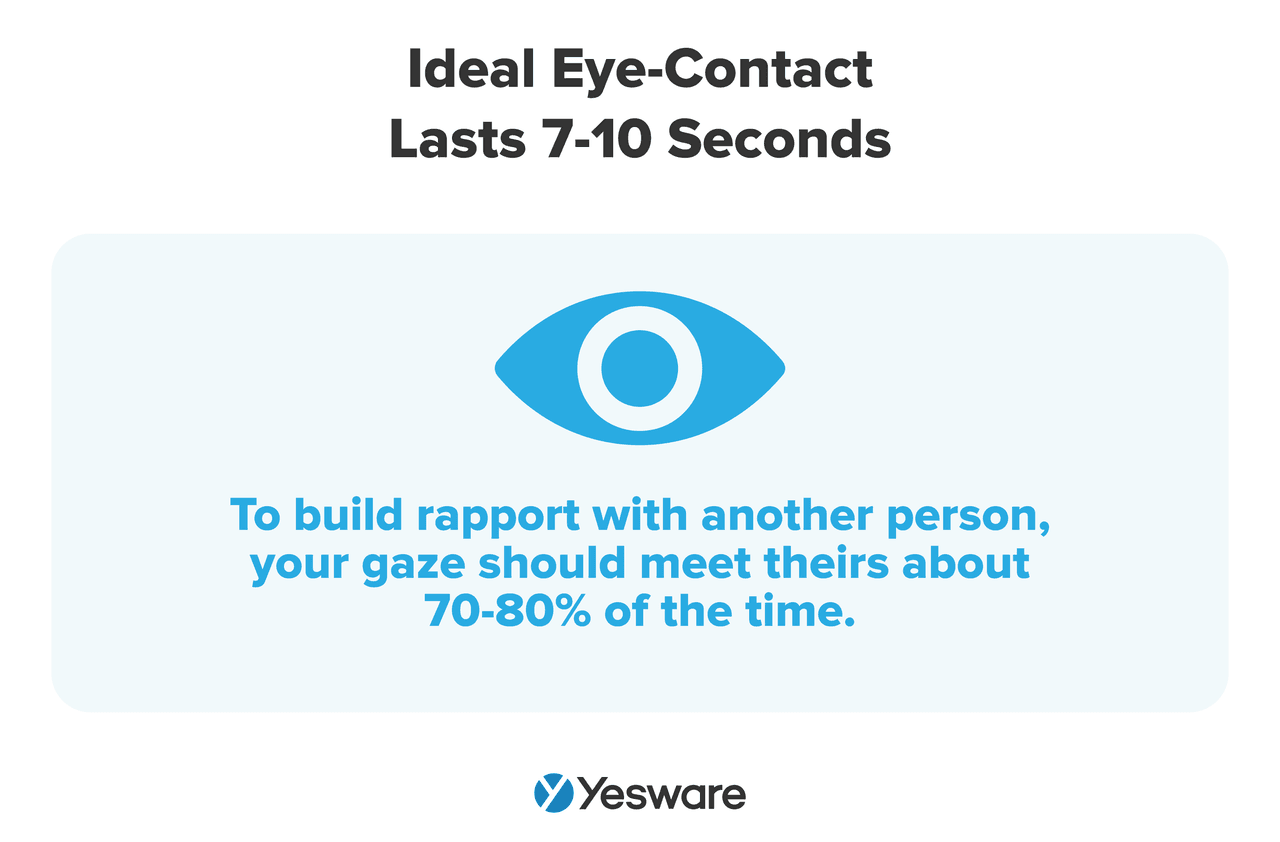
5. Find Connections Between Topics
Humans are hard-wired to connect and make connections.
Listen carefully to what the prospect says, and see if you can connect that to something you already know (either through your research or from a previous conversation). This will go a long way in showing the prospect that you’ve been listening to them and that you’re eager to understand them on a deeper level.
You could also consider connecting sentiments or ideas that the speaker shares to some of your own experiences. But be very careful to not allow yourself to take over the conversation. If you have a brief anecdote or remark that could bring you to a new level of empathy, it’s okay to share similar experiences — just keep it brief.
6. Summarize & Paraphrase
Active listeners are very proficient at summarizing and paraphrasing conversations. These two terms are often used interchangeably, but there’s nuance here again.
A summary is a brief recap of what was learned during a conversation; listeners paraphrase when they put the speaker’s ideas into their own words to clarify their understanding.
Despite their differences, both skills are extremely useful in active listening. Not only do summarizing and paraphrasing both help the sales rep gain a more thorough understanding of the speaker’s thoughts and feelings, but they also both invoke confirmation bias in the speaker. This makes the sales rep seem more trustworthy.
7. Mirror Emotions and Tone
One way to demonstrate active listening is by meeting the speaker where they are when it comes to their mood and tone.
If the prospect is really upset by their current circumstances, for example, it would be somewhat tone-deaf for a sales rep to act overly bubbly or aggressively optimistic. Instead, try to meet the speaker where they are emotionally and empathize with their circumstances.
(That’s not to say a sales rep should feed into or prolong a speaker’s frustration; their job, after all, is to solve problems for prospects. The point here is that a mismatch in emotional states can be jarring for some, so sales reps will benefit from tuning into and matching the subtleties of a speaker’s mood and energy that they bring to the conversation.)
8. Listen With Curiosity, Not Judgment
The best active listeners approach conversations with a sense of wonder and curiosity. There are no “right or wrong” answers when someone is listening to truly understand.
If you go into a sales conversation with preconceived notions about what a prospect should or should not be looking for, it may get in the way of your ability to truly hear what they actually need.
9. Be Patient
One of the most important rules of being an active listener is to actually be a listener. It’s well known that the best sales reps listen more than they talk.
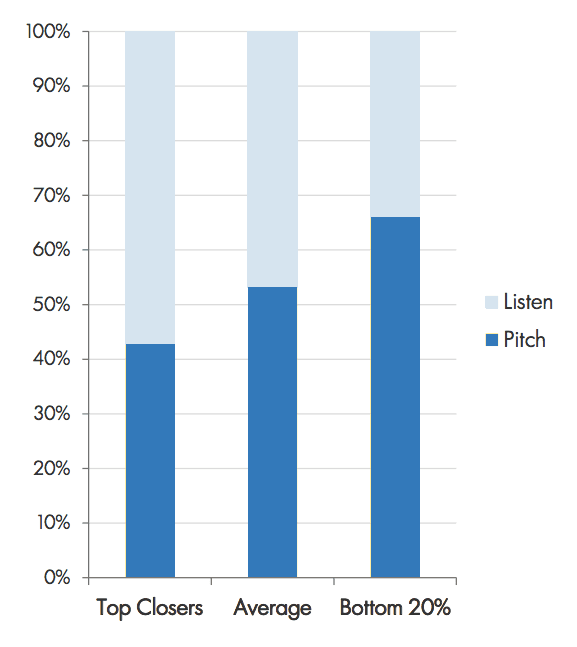
Being patient during conversation also includes avoiding interruptions, and pausing to think before replying to ensure your response is thoughtful.
10. Use Brief Verbal or Non-Verbal Affirmative Interjections
One more note on nuance: there is one exception when it comes to “interruptions.” Great active listeners know how to strategically use short, quiet, or otherwise subtle affirmative gestures to show the speaker that they’re listening and understanding.
Nodding in agreement, offering a quiet “Mmm,” or “I see,” or showing well-timed emotion on your face (e.g., raising your eyebrows during a point of emphasis) can all give positive cues to the speaker that you are invested in what they’re saying.
11. Offer Value
Just like in any other sales conversation, when in doubt: offer value. Active listeners are welcome to make connections and offer valuable (but brief) input where they see fit.
If you have expertise or insight to offer that’s relevant to the information and issues the prospect is sharing with you, providing it to them will go a long way in helping them see that you understand what they need.
Active Listening Examples
Here are some examples of how active listening could look in the context of a real sales conversation.
1. Common Objection
Sales Rep: Hi Bob, this is Jim with Yesware. Do you have a few minutes to talk about your sales engagement stats?
Prospect: Actually we feel pretty good in that department. All of our campaigns do really well.
Sales Rep: Oh, that’s great! So it sounds like you’re feeling okay with email open/reply rates and aren’t looking for any help with it. Have I got that right?
Prospect: Yeah. We’ve been really proud of how our marketing team has nailed their email copy.
Sales Rep: That’s awesome! When I talk to people like you, I often hear that the next step is figuring out how to reach more people with less effort. Does that sound like something that might be a next step for you, given how successful your campaigns are?
Prospect: Actually, yes. But we don’t really have the manpower right now to expand our outreach.
Sales Rep [Nods]: I see. So is your concern that you’ll start reaching out at scale, without enough sales reps to manage the volume of new interactions?
Prospect: Yeah, that’s a big part of it.
Sales Rep: That’s helpful to know. That’s something that Yesware specializes in — personalized outreach at scale. I’d love to set up 20 minutes next week to talk about how that looks in action. How is Tuesday at 2:00?
2. Trusted Advisor
Prospect: I’m at my wits end that we haven’t met our ARR goal again this year. I can’t stop thinking about it. This really set us back and things are absolutely going to need to change for next year, or else we’ll be in real trouble.
Sales Rep: Ugh. I can definitely feel your frustration. Sounds like the ARR has been an issue for a while and that it’s really important to you that you hit that next year. Would I be right to say that it’s a non-negotiable?
Prospect: Yes, without a doubt.
Sales Rep: What have you considered so far?
Prospect: Well, we’ve tried Strategy A and Strategy B. I’ve considered Strategy C, too.
Sales Rep: Good ideas. Have you talked to Steve over at Company 2? They actually tried implementing Strategy B last year before starting with us. Have you spoken to them lately?
Prospect: I actually haven’t yet, but that’s a good idea. Thanks.
3. Quick Recap
Sales Rep: I want to make sure I’m respectful of your time, so I want to just pause here and recap what we’ve talked about so far to make sure I have it right. Do you mind?
Prospect: Sure, go ahead.
Sales Rep: I heard you say X, Y, and Z. Have I got all of that right? Is there more you’d like me to understand?
Do you use active listening skills in sales conversations? How have they helped you improve your sales process? Which skills come most naturally to you, and which are you still practicing?
Get sales tips and strategies delivered straight to your inbox.
Yesware will help you generate more sales right from your inbox. Try our Outlook add-on or Gmail Chrome extension for free, forever!
Related Articles
Casey O'Connor
Casey O'Connor
Casey O'Connor
Sales, deal management, and communication tips for your inbox

